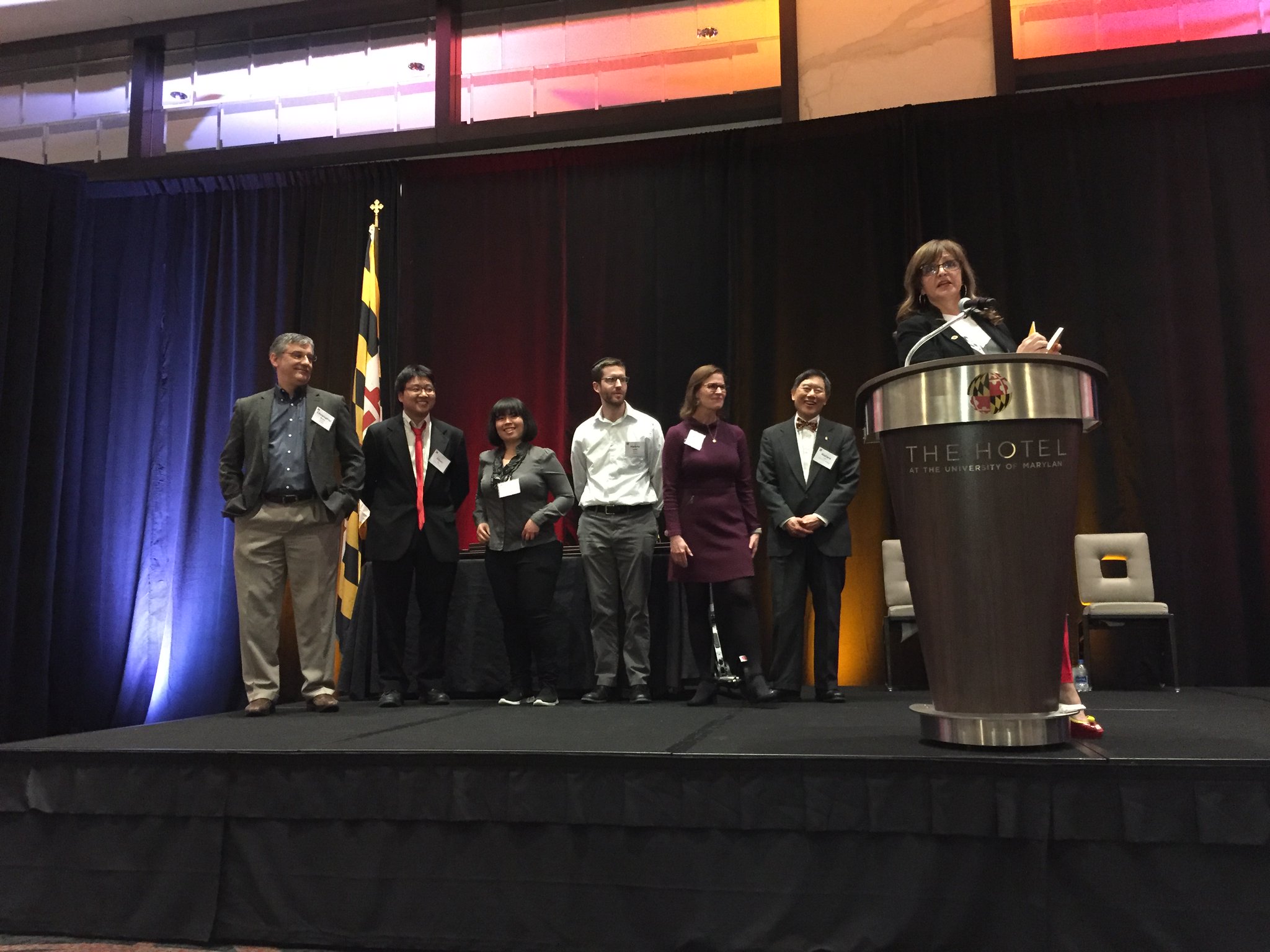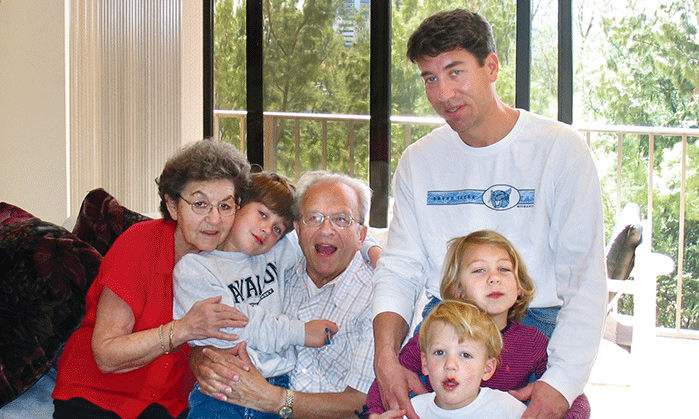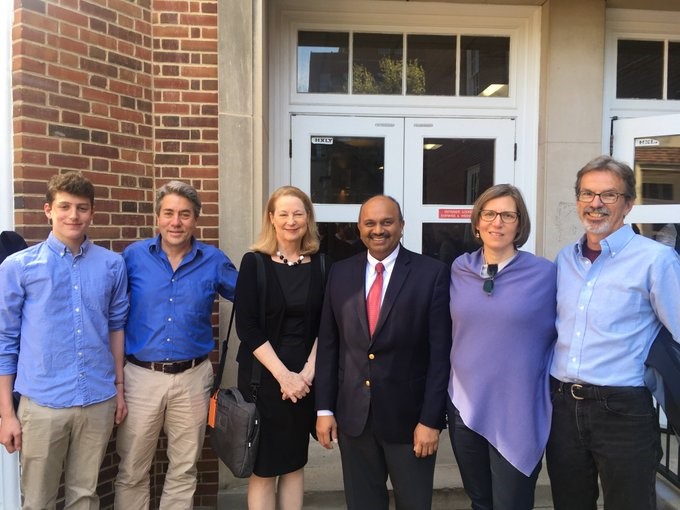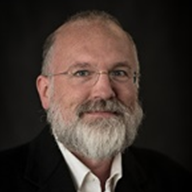Safe Resumption of Research
- Details
- Category: Department News
- Published: Thursday, May 02 2019 05:56
Before coming to campus each day, fill out the Daily Symptom Monitoring form here: https://return.umd.edu/
Overview
This document is intended to provide guidance for University of Maryland College Park (UMD) Principal Investigators (PIs) in consideration of Phase 1 re-opening of research on campus, and to provide a framework for investigators to build their re-opening plan. Below are the Guiding Principles for the Re-opening of Research developed by the UMD COVID19 Research Advisory Task Force, and the Fundamental Requirements for Re-opening, which are derived from input from the Task Force, UMD, and external resources.
Note that the specific requirements pertaining to individual plans for re-opening are subject to evolving federal, state, and local regulations, as well as changes to UMD and the USM guidelines and that further communications providing additional information or details will be forthcoming.
University of Maryland Guiding Principles for the Re-Opening of Research
University of Maryland Guiding Principles for the Re-Opening of Research
1. Follow Local, State, and Federal laws, regulations, and other Executive Orders, including but not limited orders to stay-at-home and implement social distancing.
2. Follow additional guidance and best practices issued by cognizant local, State, and federal public health authorities.
3. Prioritize physical and emotional health and safety of our campus community, our visitors, and our human research subjects.
4. Make every effort to accommodate those who are uncomfortable coming to campus.
5. Prioritize the support and cultivation of early-stage researchers: untenured faculty, postdoctoral fellows, and doctoral students. They are the drivers of the future research enterprise.
6. Recognize that undergraduates are students first, researchers second. Graduate students are students first, with research as an integral part of their education.
7. Implement a fair, transparent, and equitable process for granting access to research space.
8. Ensure that the restart of research is as rapid as the public health conditions permit.
9. Build in institutional and individual flexibility and resilience in the solutions we adopt in case severe restrictions must be invoked again.
10. Create a rich learning, mentoring, and discovery experience for researchers in a flexible environment. Cultivate a spirit of radical creativity in research. Decide now what the future of research will be.
Fundamental Requirements for Re-opening
• No research activities will be allowed during Phase 0, except for work granted an exception by Deans and VPR.
• Principal Investigators must develop plans for reopening research spaces in Phase 1. These plans must be consistent with State of Maryland and Prince George’s County laws, executive orders (as well as other applicable laws and regulations) and University guidelines, and the plan must be approved by the applicable Department Chair and Dean.
• Plans should include specific details as set forth in this guide. The VPR will provide updates to these requirements, based upon evolving conditions, regulations, and guidelines.
• During Phase 0, assessment and preparation of the research space(s) may be performed by one researcher per space, as designated by the Principal Investigator and approved by the Dean and VPR.
• Researchers should sign the Commitment to Public Health Practices included with this guidance, implement all available mechanisms for ensuring health and safety, and participate in UMD supported health screenings, contact tracing, and other means of controlling the spread of COVID-19 within the UMD campus community.
Personnel Approved To Perform Research Or Essential Services On-Campus in Phase 1
- A “researcher” is a Principal Investigator, research faculty, post-doctoral trainee, graduate student, or staff member whose primary work takes place in a research space.
- Researchers will minimize their time on campus and those who can continue to work remotely will do so.
- Researchers can freely raise concerns about any health and safety matter to the Principal Investigator, Department Chair, Dean, Human Resources, UMD’s Ethics, Integrity and Compliance Reporting system and/or the Department of Environmental Safety, Sustainability & Risk. [See Division of Research Whistleblower Protections.]
1. Social Distancing – Occupancy per Research Space
Key considerations:
- The PI must establish a plan for establishing occupancy restrictions to ensure distancing.
- Require physical separation of at least 6 feet apart in the research space, offices, and break areas.
- Limit the square footage per researcher permitted by the University based upon each space: Phase 1 not to exceed 1 person/room or 200ft2; Phase 2 not to exceed 1 person/room or 150ft2. Building floor plans with dimensions to calculate square footage can be found here.
- Design workflow to minimize the need for researchers to pass frequently by one another.
- Conduct all meetings virtually, to the best extent possible.
- During Phase 1, departments must designate a point of contact for vendors and visitors. The department is responsible for the person’s access and may not access campus facilities without the prior approval of the Dean, or designee. Urgent repairs and actions required as a result of an emergency or incident response are permitted without prior approval for access.
- Be mindful of elevator use; limit occupancy based upon social distancing requirements.
- Follow all posted traffic patterns for the building hallways, stairwells, etc.
- Post signage on research space entry doors noting permitted occupancy based upon the determined available square footage.
- Consider the use of tape on the floors to indicate workspace positioning and/or traffic flow.
- If demarcating physical distance requirements with physical barriers, be sure it is safe to do so. IMPORTANT: Barriers must not block egress and other fire/lift safety equipment, sprinklers, electrical panels, etc. Contact ESSR Fire Marshal’s Office for a review or approval.
- Use signage to mark areas and/or workstations for permissions of use or research space-specific rules (e.g., 1 person per workstation, scheduling plan, point of contact for shared spaces or equipment, cleaning and disinfection, PPE requirements, etc.).
- Consider staggering access to the spaces to limit personnel density.
- Describe these research-specific plans in the space below or attached to comply with social distancing (person/#sq ft, floorplans with possible circulation patterns in research space).
Principal Investigators may add more detailed research space-specific social distancing plans.
2. Social Distancing - Scheduling of Work Hours
Key considerations:
- The PI must establish a plan for the management of work hours.
- Consider scheduling individual shifts per day and teams to work after-regular hours.
- Include the allowance of time for individuals to clean and disinfect all surfaces, including research equipment, per Section B.5.
3. Personnel Tracking Process (Phase 1)
Occupancy tracking for researchers, vendors and visitors in the spaces will be important for contact tracing in Phase 1.
Key considerations:
- The PI must establish methods for recording and tracking occupancy (campus will provide electronic log book guidance)
- Identify persons responsible for records management.
4. Personal Hygiene Behaviors to Reduce Viral Spread
Key considerations:
- The PI is responsible for ensuring that all researchers coming to campus have access to and have reviewed information on the signs and symptoms of COVID-19 and the actions to take if they are feeling ill at home or on campus.
- Researchers will not come to campus if feeling unwell for any reason.
- Researchers will wear cloth masks when social distancing may not be possible (e.g., in hallways, stairwells, bathrooms), and in other locations where people are likely to come into contact with each other (common use spaces).
- Researchers will cover their mouths and noses when sneezing or coughing and use best practices for hygiene, including coughing or sneezing into a tissue and immediately throw it away; use arm or sleeve to cover face if no tissue available; wash hands afterward with soap and water for at least 20 seconds.
- Researchers will use best efforts to avoid touching their eyes, nose and mouth.
- Researchers will wash their hands for 20 seconds using soap and water frequently throughout the day, wash their hands after contacting surfaces that may have been touched by other persons, and use hand sanitizer when a handwashing sink is not available.
- Consider posting Center for Disease Control Guidelines in the research space for “How to Protect Yourself and Others”; “How to Stop the Spread of Germs” or other University guidelines as provided.
5. Surface Cleaning & Disinfection – Work Space and Equipment
Key considerations:
- The PI must provide details of the research space, equipment and surface cleaning and disinfection plan. Include the schedule/intervals (ideally before and after use) and the disinfection materials to be used.
- Before leaving the spaces, all researchers are responsible for cleaning and disinfecting all high contact surfaces that they may have touched, including door and drawer handles, light switches, faucets, phones, and equipment.
- Before leaving the lab spaces, clean and disinfect the space with an EPA-registered household disinfectant suggested for use against SARS-CoV-2 [list can be found at: https://www.epa.gov/pesticide-registration/list-n-disinfectants-use-against-sars-cov-2]. Follow all manufacturer’s instructions for use, including concentration and contact time.
- If bleach is used, make a 1:10 dilution of household bleach, which has a high efficacy against SARS-CoV-2. Bleach solutions will be made fresh every 24 hours to ensure potency. Note, bleach is corrosive to stainless steel and should not be used on this surface; a 70% ethanol solution is preferred.
- Consider cleaning and disinfecting electronics with alcohol-based wipes or, to reduce the risk of damage to sensitive components, a spray for electronics.
- Common use/shared PPE (face shields, safety glasses, laser safety glasses) that can be cleaned will be disinfected after use.
- Common use equipment will be cleaned and disinfected after use.
- Consider wearing clean disposable gloves under special/shared gloves (e.g. cryogen gloves, autoclave gloves).
- Researchers should wash hands before and after the use of shared equipment and shared PPE.
- Researchers will not share lab coats.
6. Illness Action and Reporting
Key considerations:
- The PI must provide a plan for action in the event that a researcher becomes ill or feels unwell while on campus.
- If unwell for any reason, the researcher should safely shut down lab work and leave campus immediately; report the reason for leaving to the Principal Investigator or supervisor via a phone call - not in person; and contact their healthcare provider for consultation.
- Individuals should report positive COVID-19 test results to the University Health Center and to their PI or supervisor.
7. Personal Safety - Measures For Working Alone and/or When Limited Personnel are on Campus
Key considerations:
- The PI must ensure that researchers have access to information regarding safety measures.
- Researchers are signed up for UMD Alerts https://alert.umd.edu.
- Researchers have the UMD Emergency Number (301-405-3333) programmed into their cell phones.
- Researchers will stay alert and attuned to people and circumstances, keep lab doors closed, limit electronic devices that block hearing or split attention making it difficult to remain vigilant, and follow the “See Something, Say Something” program to report all incidents to UMPD.
- To keep the building secure, researchers will not prop open exterior doors; when working alone in the research space, researchers must close and secure all doors.
- Consider using the UMD Guardian App when working alone.
- Researchers are familiar with the location of the exterior emergency blue light phones (https://prepare.umd.edu/blue-light-phones-0) for use in any emergency situation.
- Consider requesting a UMPD escort if researchers feel unsafe when walking across campus at night (http://www.umpd.umd.edu/services/escorts.cfm).
- When work involves the use of hazardous materials or animals, Principal Investigators must approve the research to be conducted alone, based upon a risk assessment.
8. Training & Communication
Key considerations:
- The PI must establish a training and communication strategy regarding the elements of their plan.
- Individuals approved to work on campus must have completed COVID-19 Awareness Training, to include signs and symptoms of COVID-19 and the actions to take if they are feeling ill at home or on campus.
- The Principal Investigator has shared each of the following with group members:
- The requirements for space occupancy, social distancing, and other COVID-19 safety measures.
- The Procedures for personal hygiene and self-monitoring.
- The procedures for the proper use of PPE.
- The procedures to wear face masks.
- The procedures to clean and disinfect all surfaces and equipment, including those in the labs/spaces where shared equipment use is planned.
- The procedures for ensuring personal safety, and reporting illness or potential exposure.
To minimize the risk to public health while performing research at the University of Maryland (UMD), students, staff, and faculty are expected to adhere to public health practices to minimize the spread of COVID19.
Please return completed agreement to: the Faculty PI/ Research Group Leader/Lab Director
Please note: All Forms must be shared with Department Chairs and/or Dean’s Offices
The Research Group Leader/Principal Investigator/Laboratory Director sharing this agreement understands it is their responsibility, to the best of their ability, to effectively communicate and promote these public health behaviors.
 From quantum computing and augmented reality to biomedical advances and innovative new materials, the 2018 Invention of the Year award winners spanned the range of research and entrepreneurship at Maryland.
From quantum computing and augmented reality to biomedical advances and innovative new materials, the 2018 Invention of the Year award winners spanned the range of research and entrepreneurship at Maryland.

 Gregory S. Boebinger, Director of the National High Magnetic Field Laboratory and a professor at Florida State University, will give the W.J. Carr Lecture on Tuesday, April 9 at 4 p.m. in room 1412 of the John S. Toll Physics Building. His talk is entitled
Gregory S. Boebinger, Director of the National High Magnetic Field Laboratory and a professor at Florida State University, will give the W.J. Carr Lecture on Tuesday, April 9 at 4 p.m. in room 1412 of the John S. Toll Physics Building. His talk is entitled